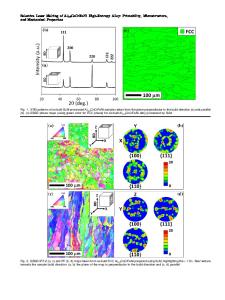Selective laser melting of 316L stainless steel: homogeneity of thermal history, microstructure, and mechanical properti
- PDF / 1,597,586 Bytes
- 8 Pages / 595.276 x 790.866 pts Page_size
- 58 Downloads / 366 Views
ORIGINAL ARTICLE
Selective laser melting of 316L stainless steel: homogeneity of thermal history, microstructure, and mechanical properties Quinton Porter 1,2 & Justin Morrow 3 & Chao Ma 1,2 Received: 22 May 2020 / Accepted: 21 October 2020 # Springer-Verlag London Ltd., part of Springer Nature 2020
Abstract Manufacturers using additive manufacturing to build parts need to know how the complex thermal histories imparted by rapid heating and cooling affect the homogeneity of the microstructure and mechanical properties within their parts. To identify the possible differences for a part built via powder bed fusion, a simulation incorporating superlayers was used to predict the thermal history for a part built by a selective laser melting process. The simulation captured effects of the increasing distance from the substrate as well as the increasing cross-sectional area for the conical geometry of the part, which were meant to exacerbate thermal history discrepancies between layers. The largest thermal gradient difference between layers was 3.7%, and the largest cooling rate difference was about 10%. Grain size and microhardness measurements on the built parts were used to determine whether the microstructure and mechanical properties changed as a function of distance from the substrate and the increasing cross-sectional area. Differences were found to be negligible because the microhardness and grain size were uniform throughout the part in the build direction. The time (8 s) required to recoat the next layer provided enough cooling time to give similar enough thermal histories to fabricate parts with consistent grain size and microhardness in the build direction. Keywords Powder bed fusion . Thermal history . Microstructure . Mechanical properties
1 Introduction The growth of interest in metal additive manufacturing (AM) has led to a multitude of new findings at the microstructural level as engineers aim to better control the properties of AMbuilt parts. Many studies have focused on the grain morphology regarding the densification, shape, and composition resulting from AM builds [1]. Investigators have consistently reported that powder bed fusion (PBF) and directed energy deposition (DED) processes form parts with finer microstructure than that of cast or wrought parts, and the isotropic grain structure typical of metal does not exist [2]. During PBF and DED builds, a part is subjected to complex thermal changes due to rapid and repeated heating and cooling cycles [3]. The * Chao Ma [email protected] 1
Department of Mechanical Engineering, Texas A&M University, College Station, TX, USA
2
Department of Engineering Technology and Industrial Distribution, Texas A&M University, College Station, TX, USA
3
Thermo Fisher Scientific, Madison, WI, USA
thermal history for each voxel influences the microstructure and mechanical properties of the part. With the current technologies, each layer may be programmed to incur different processing parameters or a complex geometry may encourage a thermal history difference between
Data Loading...











